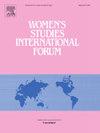伦敦两所学校对10 - 11岁学生的“理想”女学生和混合女性模式的概念
IF 1.9
3区 社会学
Q2 WOMENS STUDIES
引用次数: 0
摘要
本文探讨了伦敦两所学校的女性气质模式。研究人员在2022年对49,10 - 11岁的女孩进行了小组访谈,结果发现异性恋化、“被强调”的女性气质是一种少数形式,并引入了一种混合的女性气质,由传统的女性气质和男性气质组成。这是最常见和最具价值的版本,也与“理想化”女学生的特征有关。虽然混合形式已应用于青春期女孩和妇女,但它们在青春期前的理论不足。本文采用社会建构主义的方法,将女性视为一种关系,认为她们是暂时的、定位的、动态的和流动的。有些女孩可以是“假小子”和“少女”,而不会感到矛盾或害怕被贬低。由于找不到一种特殊的、占主导地位的女性气质,也没有性别等级制度。这篇论文表明,既不是单一的、占主导地位的形式,也不是每一种情况下女性的陡峭等级,这既不是不言自明的,也不是不可避免的,性别景观可以更均匀,也可以不那么陡峭。该研究还认为,学校可以对抗和改变不平等现象,特别是当孩子们积极参与这一过程时。本文章由计算机程序翻译,如有差异,请以英文原文为准。
Notions of the ‘ideal’ schoolgirl and hybrid patterns of femininity for 10–11-year-olds in two London schools
This paper explores patterns of femininity in two London schools. Generating data from small group interviews with 49, 10–11-year-old girls in 2022, the research found a heterosexualised, ‘emphasised’, femininity to be a minority form, and introduces a hybrid femininity, consisting of traditional feminine and masculine qualities. This was the most common and valorised version and was also connected to the characteristics of an ‘idealised’ schoolgirl. Although hybrid forms have been applied to adolescent girls and women, they are under-theorised with pre-adolescents. Taking a social constructionist approach, the paper views femininities as being relational and argues they are temporal, situated, dynamic and fluid. Some girls could be ‘tomboys’ and ‘girly-girls’ without feeling any contradiction or fear of derogation. Unable to find a particular, dominant, form of femininity, there was also an absence of gender hierarchies. The paper suggests that neither a singular and dominant form, nor a steep hierarchy of femininities in every setting, is neither axiomatic nor inevitable, and that the gender landscape can be more even and less steep. The research also argues that schools can counter and change inequalities, particularly when children are actively involved in the process.
求助全文
通过发布文献求助,成功后即可免费获取论文全文。
去求助
来源期刊

Womens Studies International Forum
WOMENS STUDIES-
CiteScore
2.50
自引率
7.10%
发文量
63
审稿时长
79 days
期刊介绍:
Women"s Studies International Forum (formerly Women"s Studies International Quarterly, established in 1978) is a bimonthly journal to aid the distribution and exchange of feminist research in the multidisciplinary, international area of women"s studies and in feminist research in other disciplines. The policy of the journal is to establish a feminist forum for discussion and debate. The journal seeks to critique and reconceptualize existing knowledge, to examine and re-evaluate the manner in which knowledge is produced and distributed, and to assess the implications this has for women"s lives.
 求助内容:
求助内容: 应助结果提醒方式:
应助结果提醒方式:


